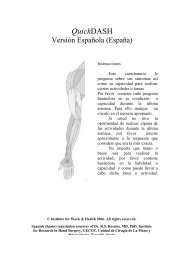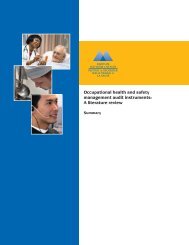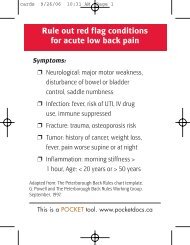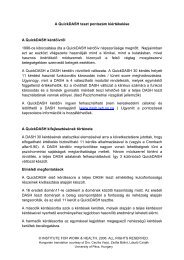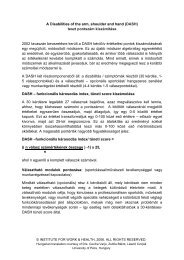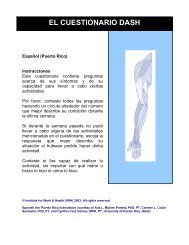A systematic review of injury/illness prevention and loss control ...
A systematic review of injury/illness prevention and loss control ...
A systematic review of injury/illness prevention and loss control ...
- No tags were found...
Create successful ePaper yourself
Turn your PDF publications into a flip-book with our unique Google optimized e-Paper software.
• Return-to-work/disability management programs (RTW/DM) werethe most common intervention evaluated (eight <strong>of</strong> the 46 studies).• Ergonomic training was evaluated in seven studies.• Programs (regulatory) <strong>and</strong> workstation adjustment were eachevaluated in five studies.• Other intervention categories examined in two or three studiesincluded: arm supports, data entry devices, exercise, policy(employer-level) <strong>and</strong> manual lifting.• The remaining interventions were represented by single studies.The categories were established with an attempt to separate the interventionsinto programs, policies or practices. However, the heterogeneity <strong>of</strong> theinterventions, sectors <strong>and</strong> outcomes made this difficult. The categorization <strong>of</strong>interventions is important because it directly affects the strength <strong>and</strong>generalizability <strong>of</strong> the results.Appendix L lists the characteristics <strong>of</strong> the <strong>review</strong>ed studies that are importantto consider when considering generalizability.Countries <strong>of</strong> originThe studies <strong>review</strong>ed originated from 12 different countries. The majority <strong>of</strong>the studies were from the USA (n=26). Sweden <strong>and</strong> Canada were the onlyother countries that accounted for more than two studies (Sweden had four<strong>and</strong> Canada had three).Types <strong>of</strong> industry/jobsOffice environments <strong>and</strong> data entry jobs were the most common industry <strong>and</strong>job function in the <strong>review</strong>ed studies. No other industry or sector dominatedthe studies <strong>review</strong>ed. Both white collar <strong>and</strong> blue collar workers wererepresented almost equally.Study designsThe data extraction studies included 21 r<strong>and</strong>omized field trials, 20 nonr<strong>and</strong>omizedfield trials, three r<strong>and</strong>omized crossovers <strong>and</strong> two quasiexperimentaldesigns. Eight <strong>of</strong> the nine high quality studies were r<strong>and</strong>omizedfield trials.Sample sizes <strong>and</strong> numbers lost to follow-upOver half <strong>of</strong> the studies did not report <strong>loss</strong> to follow-up numbers for all thegroups included in their study. The sample sizes ranged from 27 (Hager et al.1982) to over 5,000 (Wassell et al. 2000). The larger sample sizes weretypically in the policy <strong>and</strong> program interventions.A <strong>systematic</strong> <strong>review</strong> <strong>of</strong> <strong>injury</strong>/<strong>illness</strong> <strong>prevention</strong> <strong>and</strong> <strong>loss</strong> <strong>control</strong>programs (IPCs)23



